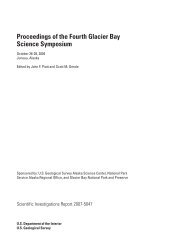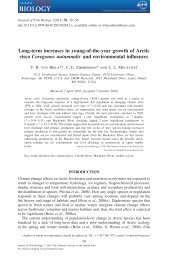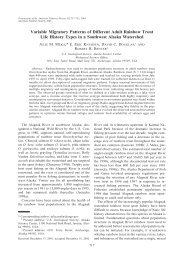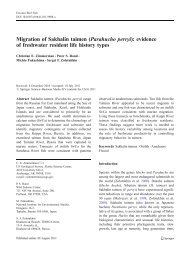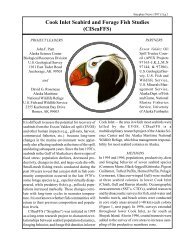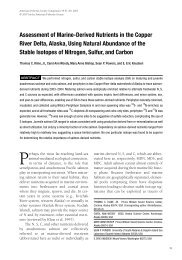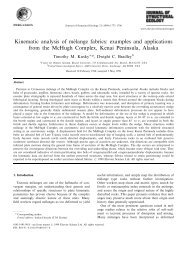Mexican native trouts: a review of their history and ... - Webspace
Mexican native trouts: a review of their history and ... - Webspace
Mexican native trouts: a review of their history and ... - Webspace
You also want an ePaper? Increase the reach of your titles
YUMPU automatically turns print PDFs into web optimized ePapers that Google loves.
298<br />
merits careful investigation,” such investigations have<br />
yet to occur; the Río Conchos headwaters remain<br />
very poorly sampled for fishes. We hypothesize that<br />
the Rio Gr<strong>and</strong>e cutthroat trout, Oncorhynchus clarkii<br />
virginalis, currently found in the Pecos <strong>and</strong> Rio<br />
Gr<strong>and</strong>e headwaters in New Mexico (Sublette et al.,<br />
1990), potentially had access to the Conchos drainage,<br />
where surely adequate habitat existed <strong>and</strong> perhaps still<br />
exists.<br />
Historical evidence from the late 1800s place Rio<br />
Gr<strong>and</strong>e cutthroat trout populations in the Guadalupe<br />
<strong>and</strong> Davis Mountains in southwestern Texas (Garrett<br />
<strong>and</strong> Matlock, 1991), near the mouth <strong>of</strong> the Río<br />
Conchos, at elevations far below those found in<br />
much <strong>of</strong> the Conchos basin. Trout scales were<br />
reported by archeologists analyzing 1,100-year-old<br />
human coprolites from shelter caves along the<br />
lowermost Pecos River in Texas (Sobolik, 1991),<br />
about 200 km below the mouth <strong>of</strong> the Río Conchos.<br />
Exp<strong>and</strong>ing on these studies indicating that trout were<br />
once present in Texas near the mouth <strong>of</strong> the Río<br />
Conchos, we here report on published <strong>and</strong> recently<br />
found archival materials that support existence <strong>of</strong><br />
a cutthroat trout in the headwaters <strong>of</strong> the Río Conchos.<br />
Were Cope’s specimens true cutthroats? The term<br />
“blackspotted trout” used by Cope in his threesentence<br />
communication (Cope, 1886) was the<br />
synonym at the time for “cutthroat trout,” <strong>and</strong> Salmo<br />
purpuratus (with which he briefly compared his<br />
specimens) is now considered a synonym <strong>of</strong> cutthroat<br />
trout, Oncorhynchus clarkii. Cope’s mention <strong>of</strong><br />
basihyal (basibranchial) teeth supports identifying<br />
the trout as a cutthroat (Behnke, 1992; Behnke <strong>and</strong><br />
Tomelleri, 2002), since rainbows <strong>and</strong> all other known<br />
<strong>Mexican</strong> <strong>trouts</strong> lack them. Furthermore, we are<br />
confident that if Cope’s specimens represented any<br />
<strong>of</strong> the currently known <strong>Mexican</strong> <strong>trouts</strong> (which were<br />
unknown in 1886), he would have surely noticed<br />
<strong>their</strong> prominent, broadly white-tipped anal <strong>and</strong> pelvic<br />
fins, a character not seen in any form <strong>of</strong> “southern”<br />
cutthroat trout (the Rio Gr<strong>and</strong>e, greenback, Colorado<br />
River, Bonneville, Yellowstone, <strong>and</strong>/or Lahontan<br />
subspecies). Cope was familiar with several forms<br />
<strong>of</strong> cutthroat trout, having collected them in the<br />
southwestern U.S., <strong>and</strong> he described Salmo spilurus<br />
(Cope, 1872), which was later synonymized with<br />
the Rio Gr<strong>and</strong>e cutthroat. The only other trout<br />
known to be <strong>native</strong> to southwestern Chihuahua<br />
(as Lupton, who provided the specimens to Cope,<br />
described his collection locality) is the <strong>Mexican</strong><br />
golden trout (Needham <strong>and</strong> Gard, 1964), found in<br />
Pacific drainage headwaters <strong>of</strong> the ríos Fuerte, Sinaloa<br />
<strong>and</strong> Culiacán, but unknown to science at the time<br />
Cope was examining Lupton’s specimens. Like other<br />
known <strong>Mexican</strong> <strong>trouts</strong>, the <strong>Mexican</strong> golden is a<br />
close relative <strong>of</strong> the rainbow trout, Oncorhynchus<br />
mykiss), with many small dark spots on the body,<br />
typically confined to the dorsal region (above the<br />
lateral line). The southern cutthroat <strong>trouts</strong> (including<br />
the Rio Gr<strong>and</strong>e cutthroat) have less pr<strong>of</strong>use spotting<br />
on the dorsum, have spots on the side <strong>of</strong> the body<br />
below the lateral line, <strong>and</strong> have a longer maxillary<br />
(upper jaw) than rainbow trout. Additionally, the<br />
Rio Gr<strong>and</strong>e cutthroat, unlike the <strong>Mexican</strong> golden,<br />
typically has a concentration <strong>of</strong> larger spots on the<br />
posterior trunk <strong>and</strong> tail region, <strong>and</strong> has basibranchial<br />
teeth. Cope clearly seems to have been looking at<br />
cutthroat specimens, not <strong>Mexican</strong> golden trout.<br />
Where were Cope’s specimens collected? The st<strong>and</strong>ing<br />
belief, expressed in the literature, that Cope’s specimens<br />
attained from Lupton were from a Pacific<br />
drainage appears erroneous, <strong>and</strong> we believe we<br />
have traced the source <strong>of</strong> the error through archived<br />
personal correspondence. The report by Jordan <strong>and</strong><br />
Evermann (1902) that cutthroat trout occurred in the<br />
Sierra Madre <strong>of</strong> Chihuahua, Mexico was undoubtedly<br />
based on Cope’s 1886 note in American Naturalist.<br />
Archived correspondence clearly indicates that<br />
Evermann (in litt., 1906, to Nelson, Archive <strong>of</strong><br />
Edward William Nelson) believed it likely that the<br />
trout mentioned by Cope (collected by Lupton) came<br />
from the Río Conchos watershed. Evermann wrote to<br />
Nelson at the Smithsonian Institution, querying about<br />
any trout the latter might have seen during his travels<br />
in the Sierra Madre Occidental, <strong>and</strong> quoting the vague<br />
locality <strong>of</strong> Lupton’s trout specimens almost verbatim<br />
from Cope’s published note (Archive <strong>of</strong> E.W. Nelson).<br />
Nelson replied that he had been in that “exact place,”<br />
where he saw trout in a stream on the Pacific slope <strong>of</strong><br />
Mt. Mohinora (he was near El Tule in the Río Sinaloa<br />
drainage) (Barton W. Evermann Archive, 1906; Field<br />
journal <strong>of</strong> E.O. Goldman, 1898). Headwaters <strong>of</strong> each<br />
<strong>of</strong> the ríos Fuerte, Conchos, Culiacán <strong>and</strong> Sinaloa<br />
all interdigitate closely on <strong>and</strong> near Cerro Mohinora.<br />
The correspondence between Evermann <strong>and</strong> Nelson<br />
clearly shows that neither knew any more <strong>of</strong> Lupton<br />
or his travels <strong>and</strong> collections in Mexico than what was<br />
described so vaguely by Cope (1886), <strong>and</strong> Nelson’s<br />
“exact place” can only be a reference to the general<br />
geography <strong>of</strong> the area as described in Evermann’s




